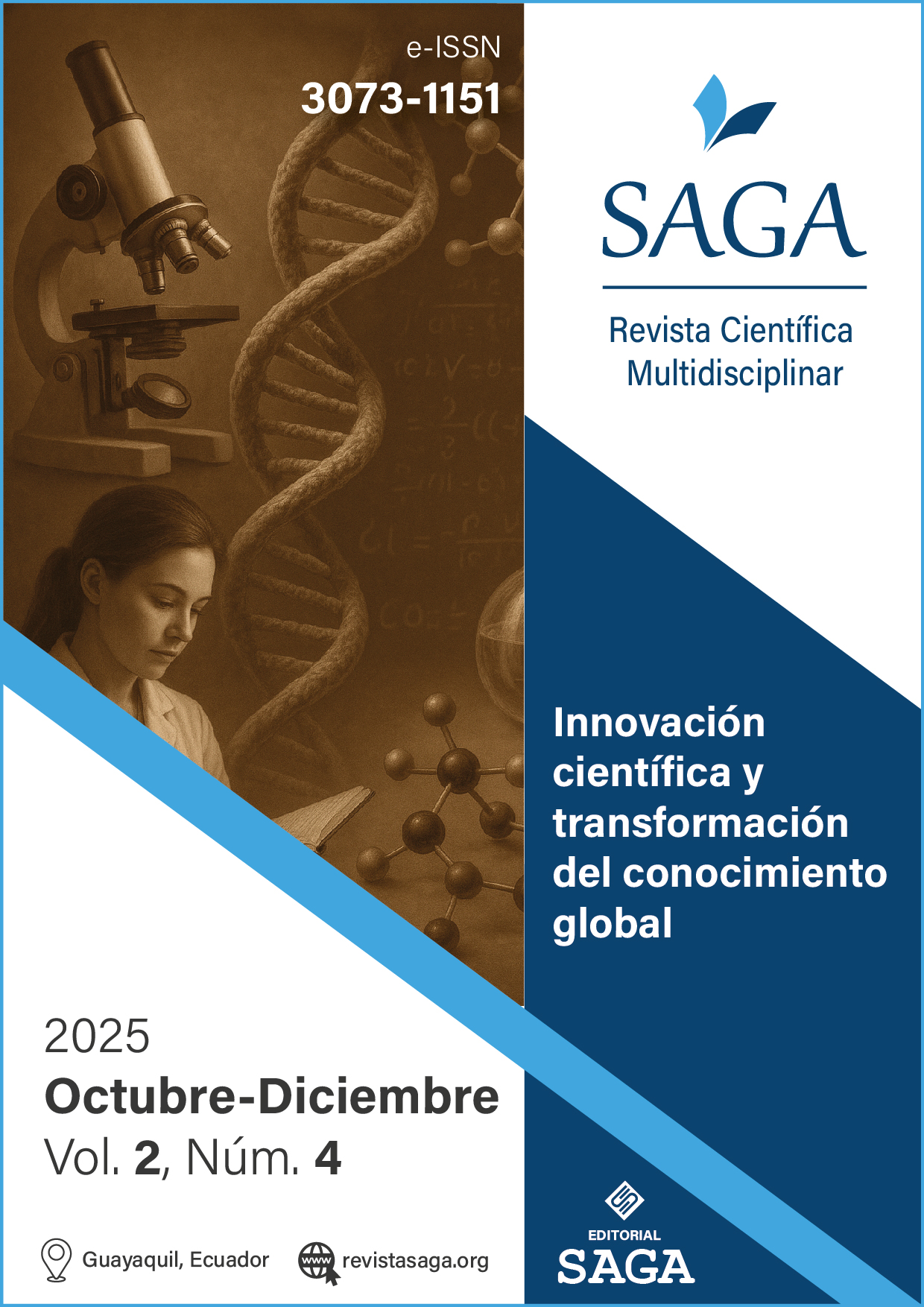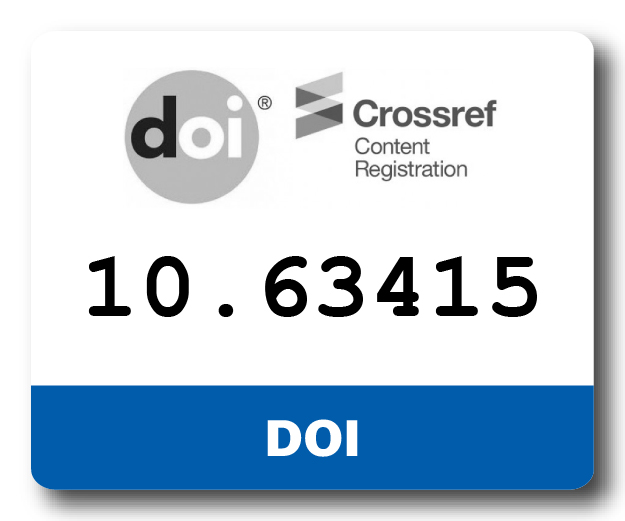Aplicación de hongos comestibles (Suillus luteus) en una bebida en polvo
DOI:
https://doi.org/10.63415/saga.v2i4.296Palabras clave:
hongos comestibles , super food , antiinflamatorio , tarwi, cacao, macaResumen
Los hongos comestibles presentes extensamente en diversas partes del mundo poseen propiedades nutracéuticas importantes que pueden ser reconocidos por como “super food”. El objetivo de esta investigación fue aplicar el hongo comestible Suillus luteus en conjunto con otros alimentos como la maca y tarwi para crear una bebida en polvo instantánea con propiedades nutritivas excepcionales. Se realizaron 4 formulaciones variando los principales ingredientes en las siguientes proporciones: S. luteus (10, 15, 15 y 20%), maca (10, 10, 15 y 15%) y cacao (35, 30, 25 y 20%), además de usar 20% de tarwi en todos las formulaciones. Se evaluaron su composición proximal, propiedades fisicoquímicas, compuestos fenólicos y capacidad antioxidante por el método ABTS. La formulación que resaltó fue el F4 (20% de hongos comestibles, 15% maca, 20% cacao y 20% de tarwi), con un 19.34 ± 0.35% de proteínas, 59.29 ± 0.80%.de carbohidratos, 48.82 ± 0.02 mgAGE/ml de fenoles totales y 20.08 ± 2.00 mmolTE/100g de capacidad antioxidante. La incorporación de los hongos en esta bebida potencializó sus propiedades nutritivas y nutracéuticas de la bebida, demostrando que su aplicación es posible en diferentes productos que promete ser una excelente alternativa sostenible para la industria alimentaria.
Descargas
Referencias
Achour, M. (2006). A new method to assess the quality degradation of food products during storage. Journal of Food Engineering, 75(4), 560-564. https://doi.org/10.1016/j.jfoodeng.2005.04.056.
Adebayo, EA., Martínez-Carrera, D., Morales, P., Sobal, M., Escudero, H., Meneses, M., Avila-Nava, A., Castillo, I., Bonilla, M. (2017). Comparative study of antioxidant and antibacterial properties of the edible mushrooms Pleurotus levis, P. ostreatus, P. pulmonarius and P. tuber-regium. Int J Food Sci Technol 53:1316–1330. https://doi.org/10.1111/ijfs.13712.
Agerer, R., (2001). Exploration types of ectomycorrhizae. Mycorrhiza 11, 107–114. http:// dx.doi.org/10.1007/s005720100108.
Alarcón Y. D. E. A., Aparicio, V. M. P., & Gonzales, G. F. (2021). The antioxidant effect of Peruvian maca (Lepidium meyenii). In Toxicology (pp. 519-525). Academic Press. Pages 519-525, ISBN 9780128190920.
Antunes, F.; Marçal, S.; Taofiq, O.; Morais, A.M.M.B.; Freitas, A.C.; Ferreira, I.C.F.R.; Pintado, M. (2020). Valorization of mushroom by-products as a source of value-added compounds and potential applications. Molecules, 25, 2672. https://doi.org/10.3390/molecules25112672.
AOAC. (2005). Official Methods of Analysis, eighteenth ed. AOAC International, Gaitherseburg.
Ariza-Ortega, J. A., García, E. A., & Rodríguez-Meléndez, C. T. (2021). Proximal chemical evaluation, antioxidant content and fatty acids in fermented and dried cocoa beans, roasted cocoa beans and cocoa pulp bar (Theobroma cacao L. Criollo cultivar). Rev. chil. nutr, 500-506. http://dx.doi.org/10.4067/S0717-75182021000400500.
Asadpoor, M.; Ithakisiou, G.N.; Henricks, P.A.; Pieters, R.; Folkerts, G.; Braber, S. (2021). Non-digestible oligosaccharides and short chain fatty acids as therapeutic targets against enterotoxin-producing bacteria and their toxins. Toxins, 13, 175. https://doi.org/10.3390/toxins13030175.
Ayaz, F. A., Chuang, L. T., Torun, H., Colak, A., Seslin, E., Presley, J., et al. (2011). Fatty acid and amino acid compositions of selected wild-edible mushrooms consumed in Turkey. International Journal of Food Sciences and Nutrition, 62, 328–335. https://doi.org/10.33483/jfpau.707014
Aytar, E. C., Akata, İ., & Açık, L. (2020). Antioxidant, antimicrobial and anti-proliferative activity of Suillus luteus (L.) Roussel extracts. Journal of Faculty Of Pharmacy Of Ankara University, 44(3), 373-387. https://doi.org/10.33483/jfpau.707014.
Badalyan SM, Barkhudaryan A, Rapior S (2021) The Cardioprotective Properties of Agaricomycetes Mushrooms Growing in the Territory of Armenia (Review). Int J Med Mushrooms 23:21–31. ISSN: 1940-4344.
Bernal-Mercado, A. T., Rodríguez-Félix, F., Barreras-Urbina, C. G., Madera-Santana, T. J., Ozuna-Valencia, K. H., Moreno-Vásquez, M. J., ... & Tapia-Hernández, J. A. (2023). Shiitake (Lentinula edodes). In Mushrooms (pp. 214-238). CRC Press.
Chen, C.; Han, Y.; Li, S.; Wang, R.; Tao, C. (2021). Nutritional, antioxidant, and quality characteristics of novel cookies enriched with mushroom (Cordyceps militaris) flour. CYTA J. Food. 19, 137–145. https://doi.org/10.1080/19476337.2020.1864021.
Chen, S., Oh, S. R., Phung, S., Hur, G., Ye, J. J., Kwok, S. L., et al. (2006). Anti-aromatase activity of phytochemicals in white button mushrooms (Agaricus bisporus). Cancer Research, 66, 12026–12034. https://doi.org/10.1158/0008-5472.CAN-06-2206.
Chen, S. Y., Tseng, J., Wu, C. R., & Lin, S. D. (2023). Quality Evaluation of Shiitake Blanched and Centrifuged Broths as Functional Instant Drinks. Foods, 12(15), 2925. https://doi.org/10.3390/foods12152925.
Dag, D.; Singh, R.K.; Kong, F. (2022). Developments in Radio Frequency Pasteurization of Food Powders. Food Rev. Int. 38,1197–1214. https://doi.org/10.1080/87559129.2020.1775641.
Desisa, B.; Muleta, D.; Jida, M.; Dejene, T.; Goshu, A.; Negi, T.; Martin-Pinto, P. (2024). Improvement of nutritional composition of shiitake mushroom (Lentinula edodes) using formulated substrates of plant and animal origins. Future Foods. 9. https://doi.org/10.1016/j.fufo.2024.100302.
Drewnowska, M., Falandysz, J., Chudzińska, M., Hanć, A., Saba, M., Barałkiewicz, D., (2017a). Leaching of arsenic and sixteen metallic elements from Amanita fulva mushrooms after food processing. LWT Food Sci. Technol. 84, 861–866. http://dx.doi.org/10.1016/J.LWT.2017.04.066.
Drewnowska, M., Hanć, A., Barałkiewicz, D., Falandysz, J., (2017b). Pickling of chanterelle Cantharellus cibarius mushrooms highly reduce cadmium contamination. Environ. Sci. Pollut. Res. Int. 24, 21733–21738. http://dx.doi.org/10.1007/s11356-017-9819-2.
Fang Y., Y. Selomulya Y., Ainsworth S., Palmer M., Chen X.D., (2011). On quantifying the dissolution behaviour of milk protein concentrate, Food Hydrocoll. 25: 503–510, https://doi.org/10.1016/j.foodhyd.2010.07.030.
Fang, C., Wang, Q., Liu, X. and Xu, G. (2017). Metabolic profiling analysis of Siraitia grosvenorii revealed different characteristics of green fruit and saccharified yellow fruit. Journal of Pharmaceutical and Biomedical Analysis, 145:158-168. https://doi.org/10.1016/j.jpba.2017.06.046.
Fang, D.; Wang, D.; Ma, G.; Ji, Y.; Zheng, H.; Chen, H.; Zhao, M.; Hu, Q.; Zhao, L. (2021). Auricularia polytricha noodles prevent hyperlipemia and modulate gut microbiota in high-fat diet fed mice. Food Sci. Hum. Wellness. 10, 431–441. https://doi.org/10.1016/j.fshw.2021.04.005.
Farzana, T., Mohajan, S., Hossain, M. N., & Ahmed, M. M. (2017). Formulation of a Protein and Fibre Enriched Soy-Mushroom Health Drink Powder Compared to Locally Available Health Drink Powders. Malaysian Journal of Nutrition, 23(1). ISSN: 1394-035X.
Fournaise, T., Petit, J., & Gaiani, C. (2021). Main powder physicochemical characteristics influencing their reconstitution behavior. Powder Technology, 383, 65-73. https://doi.org/10.1016/j.powtec.2021.01.056.
Freudig, B., Hogekamp, S., Schubert H. (1999). Dispersion of powders in liquids in a stirred vessel, Chem. Eng. Process. Process Intensif. 38 (1999) 525–532, https://doi.org/10.1016/S0255-2701(99)00049-5.
García-Pacheco, Y. E., Cabrera, D., Díaz, J. A., & Parra, S. J. (2021). Caracterización de un polvo instantáneo con fibra de yuca (Manihot esculenta C.) para preparación de una bebida láctea enriquecida. Prospectiva (1692-8261). 19 (1). p68. https://doi.org/10.15665/rp.v19i1.2344.
Global News Wire. (2020, 27 de Abril). Global Mushroom Cultivation Industry (2020 to 2025) - Economic Viability of Mushroom Cultivation and Trade by Developing Countries Presents Opportunities. https://www.globenewswire.com/news-release/2020/04/27/2022477/0/en/Global-Mushroom%20cultivation-Industry-2020-to-2025-Economic-Viability-of-Mushroom-Cultivation-and-Trade-by-Developing-Countries-Presents-Opportunities.html
Hardiyanto, Y. F., Saputro, A. D., Nurkholisa, Z., Setiyadi, P. A., Bintoro, N., & Kusuma, R. A. (2021). The effect of steaming time and types of cocoa powder on the characteristics of instantized cocoa powder made using batch-type steam jet agglomerator. In IOP Conference Series: Earth and Environmental Science (Vol. 653, No. 1, p. 012089). IOP Publishing. https://doi.org/10.1088/1755-1315/653/1/012089
Hogekamp, S., Schubert, H. (2003). Rehydration of food powders, Food Sci. Technol. Int. 9, 223–235, https://doi.org/10.1177/1082013203034938.
IDF. (1987). Détermination de la dispersibilité et de la mouillabilité, International Dairy Federation, Brussels, Belgium.
Jaworska, G., Pogoń, K., Bernaś, E., Skrzypczak, A., & Kapusta, I. (2014). Vitamins, phenolics and antioxidant activity of culinary prepared Suillus luteus (L.) Roussel mushroom. LWT-Food Science and Technology, 59(2), 701-706. https://doi.org/10.1016/j.lwt.2014.07.040.
Jedinak, A., Dudhgaonkar, S., Wu, Q. L., Simon, J., & Sliva, D. (2011). Anti-inflammatory activity of edible oyster mushroom is mediated through the inhibition of NF-κB and AP-1 signaling. Nutrition journal, 10(1), 52. https://doi.org/10.1186/1475-2891-10-52.
Kała, K., Krakowska, A., Sułkowska-Ziaja, K., Szewczyk, A., Reczyński, W., Opoka, W.,et al. (2017). Kinetics of extracted bioactive components from mushrooms in artificial digestive juices. International Journal of Food Properties, 20, 1796–1817. https://doi.org/10.1080/10942912.2016.1219742.
Kalogeropoulos, N., Mylona, A., Chiou, A., Ioannou, M. S., & Andrikopoulos, N. K. (2007). Retention and distribution of natural antioxidants (a-tocopherol, polyphenols and terpenic acids) after shallow frying of vegetables in virgin olive oil. LWT, 40(6), https://doi.org/10.1016/j.lwt.2006.07.003.
Kim, D-M, Lee, H, Yoo, S-H. (2012). Compositional changes and physical properties of soymilk prepared with pre-soaked-fermented soybean. J Kor Soc App Bio Chem 55:121–126. https://doi.org/10.1007/s13765-012-0021-4.
Lie-Piang, A., Leeman, M., Castro, A., Börjesson, E. and Nilsson, L. (2021). Investigating the effect of powder manufacturing and reconstitution on casein micelles using asymmetric flow field-flow fractionation (AF4) and transmission electron microscopy, Food Res. Int., 139, https://doi.org/10.1016/j.foodres.2020.109939.
Lin, S. D., Wu, Y. T., Lo, Y. C., & Mau, J. L. (2017). Quality characteristics of centrifuged broth from blanched Pleurotus eryngii and its application as instant drink. Journal of Food Processing and Preservation, 42(1), e13356. https://doi.org/10.1111/jfpp.13356.
Liu, Q., Sun, L., Ding, Y., & Zhuang, Y. (2023). Chemical composition, health benefits, food processing effects and applications of Boletus: a review. Critical Reviews in Food Science and Nutrition, 64(29), 10812–10834. https://doi.org/10.1080/10408398.2023.2229426
Łysakowska, P.; Sobota, A.; Wirkijowska, A. (2023). Medicinal mushrooms: Their bioactive components, nutritional value and application in functional food production—A review. Molecules. 28, 5393. https://doi.org/10.3390/molecules28145393.
Miao, J.; Regenstein, J.M.; Qiu, J.; Zhang, J.; Zhang, X.; Li, H.; Zhang, H.; Wang, Z. (2020). Isolation, structural characterization and bioactivities of polysaccharides and its derivatives from Auricularia - A review. Int. J. Biol. Macromol. 150, 102–113. https://doi.org/10.1016/j.ijbiomac.2020.02.054.
MIDAGRI – Ministerio de Desarrollo Agrario y Riego. (2024. 9 de marzo). Agricultoras quintuplicaron sus ingresos con la recolección de hongos comestibles.https://www.gob.pe/institucion/agroideas/noticias/928086-agricultoras-quintuplicaron-sus-ingresos-con-la-recoleccion-de-hongos-comestibles
Mimouni, A., Deeth, H.C., Whittaker, A.K., Gidley, M.J., Bhandari, B.R. (2010). Investigation of the microstructure of milk protein concentrate powders during rehydration: alterations during storage, J. Dairy Sci. 93:463–472, https://doi.org/10.3168/jds.2009-2369.
MINSA – Ministerio de Salud. (2006). R.M. N° 451-2006/MINSA “Norma Sanitaria para la Fabricación de Alimentos a Base de Granos y otros, destinados a Programas sociales de Alimentación”. Perú. https://www.gob.pe/institucion/minsa/normas-legales/251548-451-2006-minsa.
Mongkontanawat, N., & Phuangborisut, S. (2019). Product development of mushroom beverage with high β-glucan content from local mushrooms. International Journal of Agricultural Technology 15(6):959-974. ISSN 2630-0192.
Muszyńska, B., Grzywacz-Kisielewska, A., Kała, K., & Gdula-Argasińska, J. (2018). Anti-inflammatory properties of edible mushrooms: A review. Food Chemistry, 243, 373-381. https://doi.org/10.1016/j.foodchem.2017.09.149.
Pandey, M.; Satisha, G.C.; Azeez, S.; Kumaran, G.S.; Chandrashekara, C. (2022). Mushrooms for integrated and diversified nutrition. J. Hortic. Sci. 17, 6–18. https://doi.org/10.24154/jhs.v17i1.1193.
Pandey, A. K., & Chauhan, O. P. (2019). Monk fruit (Siraitia grosvenorii)-health aspects and food applications. Pantnagar Journal of Research. 17 (3). 191-198.
Paucar-Menacho, L. M., Schmiele, M., Vásquez Guzmán, J. C., Rodrigues, S. M., Simpalo-Lopez, W. D., Castillo-Martínez, W. E., & Martínez-Villaluenga, C. (2024). Smart pasta design: Tailoring formulations for technological excellence with sprouted quinoa and kiwicha grains. Foods, 13(2), 353. https://doi.org/10.3390/foods13020353
Pereira, E., Barros, L., Martins, A., & Ferreira, I. C. (2012). Towards chemical and nutritional inventory of Portuguese wild edible mushrooms in different habitats. Food Chemistry, 130(2), 394-403. https://doi.org/10.1016/j.foodchem.2011.07.057.
Pilco-Quesada, S., Tian, Y., Yang, B., Repo-Carrasco-Valencia, R., & Suomela, J. P. (2020). Effects of germination and kilning on the phenolic compounds and nutritional properties of quinoa (Chenopodium quinoa) and kiwicha (Amaranthus caudatus). Journal of Cereal Science, 94,102996. https://doi.org/10.1016/j.jcs.2020.102996.
Qiu, Y.; Lin, G.; Liu, W.; Zhang, F.; Linhardt, R.J.; Wang, X.; Zhang, A. (2024). Bioactive compounds in Hericium erinaceus and their biological properties: A review. Food Sci. Hum. Wellness. 13, 1825–1844. https://doi.org/10.26599/FSHW.2022.9250152.
Rahman, MA., Rahman, MS., Bashir, NM., Mia, R., Hossain, A., Saha SK., Kakon, AJ., Sarker, NC. (2021) Rationalization of mushroom-based preventive and therapeutic approaches to COVID-19: Review. Int J Med Mushrooms 23:1–11. http://doi.org/10.1615/IntJMedMushrooms.2021038285
Re, R., Pellegrini, N., Proteggente, A., Pannala, A., Yang, M., & Rice-Evans, C. (1999). Antioxidant activity applying an improved ABTS radical cation decolorization assay. Free Radical Biology & Medicine, 26(9–10): 1231–1237. http://dx.doi.org/10.1016/S0891-5849(98)00315-3
Ribeiro, B., Lopes, R., Andrade, P. B., Seabra, R. M., Goncalves, R. F., Baptista, P., Quelhas, I., Valentão, P. (2008). Comparative study of phytochemicals and antioxidant potential of wild edible mushroom caps and stipes. Food Chemistry, 110, 47e56. https://doi.org/10.1016/j.foodchem.2008.01.054.
Rudawska, M., Leski, T., (2005). Trace elements in fruiting bodies of ectomycorrhizal fungi growing in Scots pine (Pinus sylvestris L.) stands in Poland. Sci. Total Environ. 339, 103–115. http://dx.doi.org/10.1016/j.scitotenv.2004.08.002.
Salazar, D., Arancibia, M., Ocaña, I., Rodríguez-Maecker, R., Bedón, M., López-Caballero, M. E., & Montero, M. P. (2021). Characterization and technological potential of underutilized ancestral andean crop flours from Ecuador. Agronomy, 11(9), 1693. https://doi.org/10.3390/agronomy11091693.
Shittu, T. A., & Lawal, M. O. (2007). Factors affecting instant properties of powdered cocoa beverages. Food chemistry, 100(1), 91-98. https://doi.org/10.1016/j.foodchem.2005.09.013
Singh, A., Saini, R. K., Kumar, A., Chawla, P., & Kaushik, R. (2025). Mushrooms as Nutritional Powerhouses: A Review of Their Bioactive Compounds, Health Benefits, and Value-Added Products. Foods, 14(5), 741. https://doi.org/10.3390/foods14050741.
Singleton, V. L., & Rossi, J. A. (1965). Colorimetry of total phenolics with Phosphomolybdic - phosphotungstic acid reagents. American Journal of Enology and Viticulture, 16: 144–158. https://doi.org/10.5344/ajev.1965.16.3.144
Sławińska, A.; Sołowiej, B.G.; Radzki, W.; Fornal, E. (2022). Wheat Bread Supplemented with Agaricus bisporus Powder: Effect on Bioactive Substances Content and Technological Quality. Foods. 11, 3786. https://doi.org/10.3390/foods11233786.
Sova, M.; Saso, L. Natural sources, pharmacokinetics, biological activities and health benefits of hy-droxycinnamic acids and their metabolites. Nutrients 2020, 12, 2190. https://doi.org/10.3390/nu12082190.
Srivastava, A., Attri, B., & Verma, S. (2019). Development and evaluation of instant soup premix using oyster mushroom powder. Mushroom Res, 28(1), 65-69. https://doi.org/10.36036/MR.28.1.2019.91960
Su, Y.; Li, L. (2020). Structural characterization and antioxidant activity of polysaccharide from four auriculariales. Carbohydr. Polym. 229, 115407. https://doi.org/10.1016/j.carbpol.2019.115407.
Suri, S., Kathuria, D., Mishra, A., & Sharma, R. (2020). Phytochemical composition and pharmacological impact of natural non-calorie sweetener- monk fruit (Siraitia grosvenorii): a review. Nutrition & Food Science, ahead-of-print(ahead-of-print). doi:10.1108/nfs-09-2020-0350
Tachabenjarong, N.; Rungsardthong, V.; Ruktanonchi, U.; Poodchakarn, S.; Thumthanaruk, B.; Vatanyoopaisarn, S.; Suttisintong, K.; Iempridee, T.; Uttapap, D. (2022). Bioactive compounds and antioxidant activity of Lion’s Mane mushroom (Hericium erinaceus) from different growth periods. E3S Web Conf. 355, 02016. https://doi.org/10.1051/e3sconf/202235502016
Vaz, J. A., Barros, L., Martins, A., Morais, J. S., Vasconcelos, M. H., & Ferreira, I. C. F. R. (2011). Phenolic profile of seventeen Portuguese wild mushrooms. LWT, 44, 343-346. https://doi.org/10.1016/j.lwt.2010.06.029.
Yang, S.; Wu, C.; Yan, Q.; Li, X.; Jiang, Z. (2023). Nondigestible functional oligosaccharides: Enzymatic production and food applications for intestinal health. Annu. Rev. Food Sci. Technol. 14, 297–322. https://doi.org/10.1146/annurev-food-052720-114503.
Yu, C.; Dong, Q.; Chen, M.; Zhao, R.; Zha, L.; Zhao, Y.; Zhang, M.; Zhang, B.; Ma, A. (2023). The effect of mushroom dietary fiber on the gut microbiota and related health benefits: A review. J. Fungi, 9, 1028. https://doi.org/10.3390/jof9101028.
Yulianti, R., & Shih, Y. C. (2024). Mixture Design Approach on Mushroom-Berry Drink Formulation: Optimization Based on Physicochemical Characteristics, Antioxidant Activities and Sensory Properties. Research and Innovation in Food Science and Technology, 13(3), 129-134. https://doi.org/10.22101/JRIFST.2023.384635.1437.
Zang, J., Qing, M., Ma, Y., Chi, Y., & Chi, Y. (2023). Shelf-life modeling for whole egg powder: Application of the general stability index and multivariate accelerated shelf-life test. Journal of Food Engineering, 340, 111313. https://doi.org/10.1016/j.jfoodeng.2022.111313
Zhang C, Li S, Zhang J, Hu C, Che G et al (2016) Antioxidant and hepatoprotective activities of intracellular polysaccharide from Pleurotus eryngii SI-04. Int J Biol Macromol 91:568–577. https://doi.org/10.1016/j.ijbiomac.2016.05.104
Zhou, Z.; Liang, S.; Zou, X.; Teng, Y.; Wang, W.; Fu, L. (2023). Determination of Phenolic Acids Using Ul-tra-High-Performance Liquid Chromatography Coupled with Triple Quadrupole (UHPLC-QqQ) in Fruiting Bodies of Sanghuangporus baumii (Pilát) LW Zhou and YC Dai. Plants.12, 3565. https://doi.org/10.3390/plants12203565.
Zocher, A. L., Kraemer, D., Merschel, G., & Bau, M. (2018). Distribution of major and trace elements in the bolete mushroom Suillus luteus and the bioavailability of rare earth elements. Chemical Geology, 483, 491-500. https://doi.org/10.1016/j.chemgeo.2018.03.019.
Publicado
Número
Sección
Licencia
Derechos de autor 2025 Ariel Gonzales, Silvia Pilco Quesada (Autor/a)

Esta obra está bajo una licencia internacional Creative Commons Atribución-NoComercial 4.0.



























